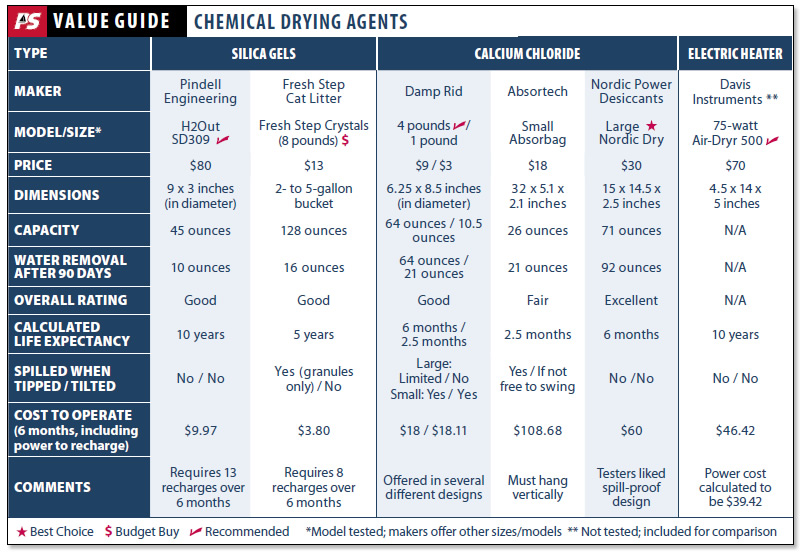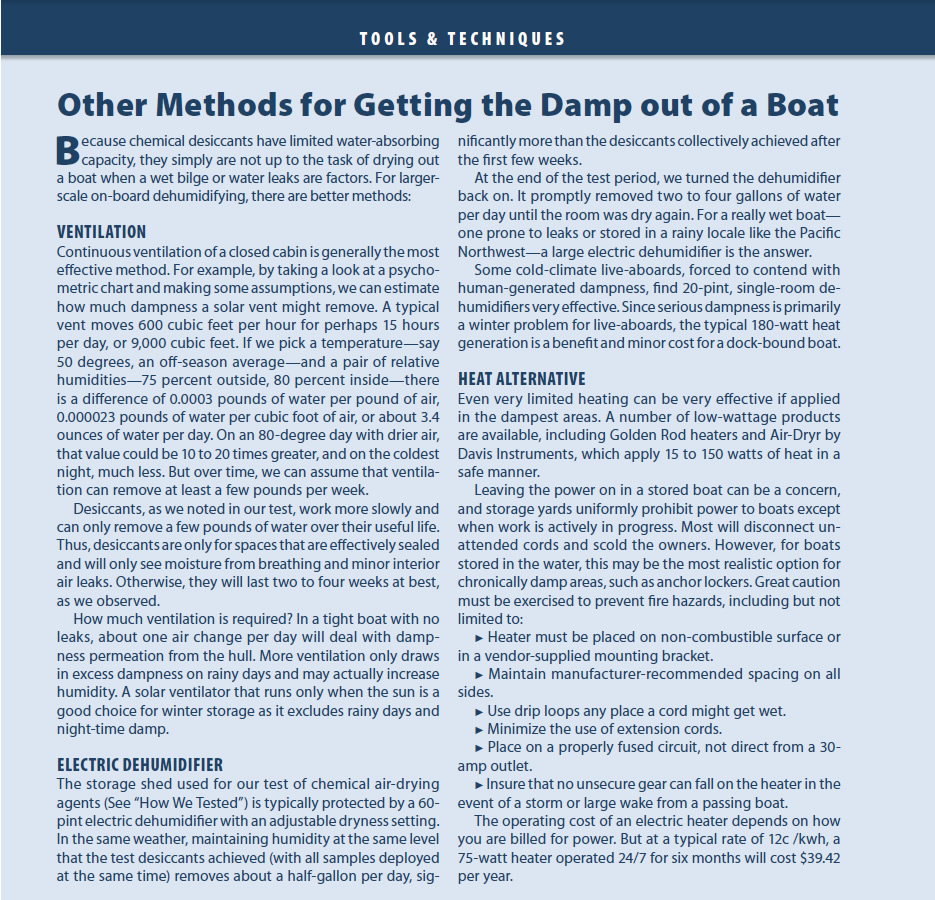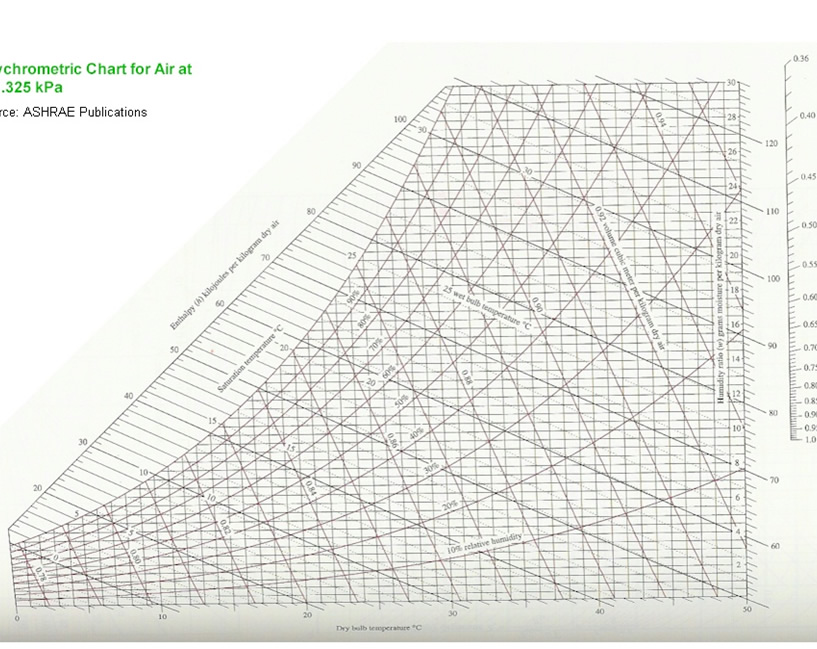Photo courtesy of Mahina Expeditions
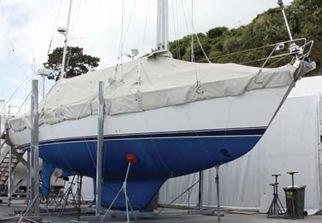
A warm, damp, dark place-like the cozy cabin of a closed boat-is the perfect incubator for mildew and corrosion, nasties familiar to all boat owners. Much can be done to ward off the offenders with ventilation and by chasing leaks, but in the end, tight spaces and perhaps a little free water in the bilge may remain, creating a breeding ground for the dreaded invaders.
With the winter haul-out season upon us, Practical Sailor testers thought it a good time to look at ways to keep cabins dry during off-season storage. There are a number of de-humidifying methods and products available, with ventilation being the most effective. Other options include electric dehumidifiers, absorbent chemicals (desiccan’ts), and electric heaters. Our test focused on chemical desiccan’ts, including calcium chloride and silica gel, but you can find out more about the other methods in Tips & Techniques (On Right). Its a good idea to use a combination of methods to keep your boat mildew-free.
Humidity 101
The first step to fighting onboard mildew and corrosion is to know thine enemy: humidity. Humidity is defined as the amount of water vapor in the air. It is the source of all forms of condensation, a leading cause of mold and mildew on boats. The warmer the air, the greater capacity it has to hold water, and the more dramatic the effect when it reaches its saturation point or dew point. Relative humidity is the ratio of the airs actual water vapor to the greatest amount possible (saturation) at the same temperature; the damper the air is, the higher the relative humidity.
Standards set by the American Society of Heating, Refrigerating, and Air-Conditioning Engineers (ASHRAE) and the U.S. Environmental Protection Agency (EPA) consider relative humidity in the 25- to 60-percent range to be livable. Any less, and some people will suffer from dry sinuses; any more, and mold or mildew become an issue.
Engineers use a complicated graph called a psychometric chart to calculate humidity. The practical lesson that can be gleaned by analyzing one of these charts is that in order to keep condensation from occurring-and mold from growing-daytime onboard humidity should be kept at 60 to 65 percent or lower. It should be low enough that night-time temperatures do not allow dew condensation to form inside the boat. (Check out this article online to see the chart, or web search ASHRAE psychometric chart.)
Condensation from air temperatures rising and falling isn’t the only source of onboard humidity. Water can also come from leaks, the bilge, or from the drying of the hull. Even with an effective barrier coat, fiberglass hulls absorb water, which will evaporate into the cabin during the winter. Consider the possible water sources on your boat before determining which dehumidifying approach will work best.
Desiccan’ts
Absorbent vs. Adsorbent: Nope, we didnt get the spelling wrong. They really are two different words. To absorb is to suck up or drink in a liquid (like a sponge), and to adsorb is to gather a gas, liquid, or dissolved substance on a surface in a condensed layer (like charcoal adsorbs gases).
Calcium chloride is the classic damp absorbent. This salt is very hygroscopic-it draws water into itself-and will literally dissolve in the water it attracts. Typically, it will absorb two to three times its weight in water, depending on temperature and relative humidity.
The salt in seawater is also hygroscopic; it holds dampness between metal parts, adding to its inherently corrosive nature (and explaining why clothes rinsed in seawater take forever to dry). In fact, since it is primarily the chloride ion that makes seawater corrosive, calcium chloride brine spills are logically highly corrosive and should be cleaned up to prevent damage.
In theory, calcium chloride can be dried and reused, but in practice, it is completely impractical, and the products are disposable. Silica gel, on the other hand, is reusable. For non-industrial users, the regeneration process is either to leave the adsorbent in the container or to spread bulk adsorbent on a shallow baking pan and cook it at 325 degrees for two hours. This will dry the adsorbent to like-new condition and can be done numerous times. Using a kitchen oven to dry the litter during our tests, there was no noticeable odor during the process.
Do not regenerate adsorbents that have been contaminated with chemical vapors, such as fuel, gasoline, or paint vapors. Typically silica gel will adsorb 0.2 to 0.35 times its weight in water, depending on temperature and relative humidity.
The bottom line? Calcium chloride absorbs about 10 times more water than silica gel, but silica gel can be regenerated hundreds to thousands of times while calcium chloride-which must be specially packaged to make it spill-proof-is single-use.
What We Tested
Practical Sailor evaluated two brands of silica-gel desiccan’ts, Pindell Engineerings H2Out and Fresh Step Crystals cat litter, and three calcium chloride products, Absortechs Absorbag, Nordic Power Desiccan’ts Nordic Dry, and W.M. Barrs DampRid. All of the test products, except Nordic Dry, are readily available from online retailers or at big box stores like Walmart. At presstime, Nordic Drys website was under construction, and they recommended customers call 508/332-8682 for more information or to purchase the product.
The Washington state-based Pindell makes products that prevent water contamination in fuel, hydraulic fluids, and interior spaces. Both Absortech, a Swedish company, and Nordic Desiccan’ts, which is head-quartered in Indonesia, manufacture moisture-control products for the transportation industry. DampRid-maker W.M. Barr Corp. is an employee-owned, U.S.-based manufacturer that specializes in maintenance products, including CitriStrip paint stripper (PS, May 2008) and Armor All.
How We Tested
The test site for this evaluation was a backyard shed located in a shaded corner of a wooded lot near the Chesapeake Bay. Built on a concrete slab in a low-lying area, the shed always seemed far more humid than the typical boat. (A 60-pint electric dehumidifier had been used for years to keep down the mold.) It seemed like a valid test bed, and so with the dehumidifier unplugged for the first time in many years, the testing began.
The procedure was quite simple: Weigh each test subject, deploy according to manufacturer instructions, and measure the gain-in-weight each week for 90 days (from mid-June to mid-September). In this way, testers evaluated both speed of moisture absorption and total holding capacity. In the case of silica-gel desiccan’ts, we put them through several regeneration cycles and confirmed that they regained full efficiency after regeneration.
We werent particularly concerned with the maximum level of dryness attained, because as we mentioned, these products are going to reach equilibrium levels defined by the chemical nature of the materials involved. So long as we could keep the humidity in summer shed test below 80 percent, we were satisfied, and until near the end of the test, as the samples became expended, it stayed in that range. For the most part, dryness in a boat locker will depend on capacity and the amount of humidity seeping in from outside. In our test shed, most dampness comes up through the floor.
Temperature is an important variable in evaluating dehumidifying devices. The psychometric chart we mentioned previously shows that summer air typically holds three times as much water as winter air, and evaporation is also slowed by cold. Thus, we expect that in a winter-stored boat, the test products would last more than three times as long as they did in our tests. We also assumed that a boat is typically stored for about six months, which is the norm on the Chesapeake Bay. Because of the warm temperatures and high humidity during our evaluation, we believe our 90-day test is equivalent to a six- to eight-month winter storage season.
Youll also note that in the Value Guide table, weve included data on a 75-watt electric-heat dehumidifier, Davis Instruments Air-Dryr 500. We included it for comparison sake, but we did not test it in this evaluation. Testers calculated the Air-Dryrs water-removal data using the psychometric chart. While heaters do not reduce humidity, per se, they provide heat, which prevents condensation-which is roughly equivalent to that amount of water removal. Its power consumption is based on manufacture specifications. Testers have used these heaters in the past and know them to be effective in a medium-size cabin.
Weve also calculated and listed in the Value Guide the six-month operating cost for each product (to remove 1 gallon of water), which takes into consideration the number of recharges required over that time and the power cost.
www.mahina.com
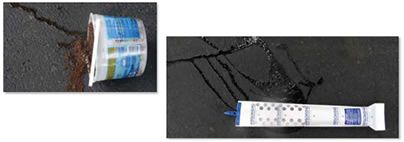
Calcium Chloride Absorbents
Absorbag
The Absorbag is a long, rectangular bag designed to be hung up. Inside the bag is a calcium chloride-filled mesh container that drips into the lower portion of the bag, gradually filling it with brine. The small version we tested contains 1.65 pounds of calcium chloride ($18), but a larger version is available (3.3 pounds of calcium chloride, $26).
In our test, the Absorbag lasted about 60 days before reaching saturation. It eventually absorbed 1.5 pounds of water. Once the calcium chloride crystals disappeared from the top bag, it was effectively finished.
As long as it remains hanging vertically, the Absorbag is not likely to leak. However, testers noted that if a nearly full bag is laid down, it will spill the brine. Even moderate shaking caused brine to spill out of the nearly full bag during tests. Users should be careful when handling the bag to not spill the brine. This is a drawback for on-board applications, unless there is a place to hang the bag where it will remain vertical-immune to wave action-and it is removed before leaving the dock. Absortech offers another product that uses a gel desiccan’t, and it would likely be a better choice for using onboard.
Bottom line: The potential for on-board brine spills kept the Absorbag out of the winners circle in this test; however, it would be fine for boats stored on the hard, as long as users handle it carefully.
DampRid
A slightly new take on the traditional calcium chloride in a bucket, the high-capacity DampRid ($9) holds 4 pounds of calcium chloride and absorbent suspended in a simple plastic tray over a bucket filled with a sawdust-like solid absorbent intended to reduce potential for spills if its knocked over. The calcium chloride gradually disappears, leaving saturated sawdust behind.
It absorbed about 4 pounds of water during the 90-day test and would probably absorb 5 pounds before becoming fully saturated. At the end of the test period, though most of the calcium chloride crystals were gone, it continued to absorb at a reduced rate; it seemed clear to us that it would last through a six-month storage period.
The high-capacity DampRid has a low spill potential, but it is not sealed. In tests, a small amount of brine spilled out when the bucket was knocked over and left there for several minutes.
The small DampRid absorber ($3), however, contains only 10.5 ounces of calcium chloride and lacks the granular solid absorbent. Unlike its big brother, this product will spill easily if overturned. During the 90-day test, it absorbed 1 3/8 pounds of water. At the end of the test period, all of the calcium chloride crystals were gone; it should through last six months of winter storage.
While we tested the bucket versions of DampRid, it is available in other forms, including sachets, hanging bags, and easy-fill systems.
Bottom line: Testers like the simplicity of the DampRid design, but we wouldnt use the smaller version on board. The high-capacity DampRid gets PSs Recommendation.
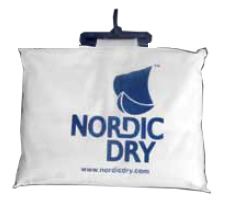
Nordic Dry
The Nordic Dry was the only calcium-chloride product we tested that was absolutely spill proof. It contains a polymer that gels the calcium chloride brine within a polymer membrane. The bag can be hung in a locker or laid on the floor without any risk of damage to what it touches. We tested this by laying it on various flat surfaces (porous and non-porous) for several weeks, and no seepage was observed. We also dropped it from shoulder height a few times and found no leaks.
We hung up the Nordic Dry for testing so that all sides were exposed, assuming this maximized its performance. After 90 days, it had absorbed 5.75 pounds of water, but it would clearly last through a six-month storage period.
It was a bit difficult to tell when the Nordic Dry was expended. The bag gets lumpy and has an obvious weight gain, but there is no clear indicator it has reached its holding capacity.
The Nordic Dry we tested contained 4.4 pounds of calcium chloride and retails for $30.
Bottom line: The Nordic Dry earned PSs Best Choice pick because it will last the season and is spill proof.

Silica Gel Adsorbents
H2Out SD109
Available in a variety of sizes, H2Out contains silica gel inside a sturdy, perforated stainless-steel sheet cartridge. Unless run over or dropped in oil, the cartridges should last as long as you have need for them.
When fully spent, the blue beads of silica gel become pink. To regenerate the beads, users simply bake the cartridge in the oven for two hours. We tested this through several cycles, and each time, they performed like new.
Like all silica-gel drying products, the H2Out has limited capacity and saturates quickly. In our test, the product became saturated within two weeks. Unlike the calcium chloride products, it would not last a six-month storage season unless used inside a sealed container or regenerated frequently. The SD109 test unit removed about 5/8-pound of water during each saturation/regeneration cycle.
Testers liked the ruggedness and design of the H2Out product. It would be a good choice for drying out small spaces like sail bags and stored apparel, where brine spills would be intolerable.
The reusable H2Out products range from $24 to $80.
Bottom line: The most durable drying product we tested, H2Out is recommended for use in small spaces, where spills would be unacceptable, and where it will be checked fairly regularly.
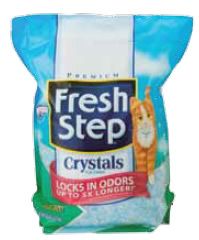
Fresh Step Crystals
Fresh Step Crystals is a very specific type of cat litter. It is made of the same adsorbent that powers H2Out and other silica-gel products, but it is a lower grade.
Testers expected the bagged litter to be overly labor intensive to use and regenerate due to its lack of usable packaging, but we devised a simple process that turned out be eco-friendly and inexpensive. We recommend purchasing two bags or buckets of Fresh Step Crystals. If you buy the bags, regenerate the contents before the first use in case the bag has an unseen tear. To do this, pour the crystals into a large cake pan (used only for this purpose) and bake them at 325 degrees for two hours. After cooling, store the crystals in sealed, five-gallon buckets; to use, simply remove the lid and place the bucket on board.
This product became saturated within two weeks in a shallow tray and within six weeks when tested in a bucket. The only way it would last a six-month storage season would be if it were regenerated mid-season. A single 8-pound bag removed 1-pound of water during each saturation/regeneration cycle.
Despite being less efficient per pound than H2Out, Fresh Step earned testers favor because it is reusable, eco-friendly, and very cheap. You can find an 8-pound bag for about $14 at most grocery or pet-supply stores.
Bottom line: Its a bit more work to regenerate and use, but the Fresh Step gets the Budget Buy pick for its outstanding economy and easy availability.
Conclusions
At the end of the desiccan’ts test, we turned on a 60-pint Kenmore dehumidifier to see how much moisture remained in the test shed after the desiccan’ts had removed all they could. The dehumidifier promptly began pulling two to three gallons of water per day out of the room for several days. Suffice it to say that chemical drying agents cannot approach the performance of ventilation, heat, or electric dehumidifiers. However, their simplicity and low cost make them attractive options for some on board applications, and they can be used to supplement other drying methods.
So which is better, calcium chloride or silica gel? One of silica gels weaknesses is its absorption speed. If exposed to high humidity, it can saturate in a week or two. Calcium chloride products, however, are self-limiting with regard to speed, so they last longer and have 10 times more drying capacity per unit weight than silica gel.
The best choice depends on the planned application. To keep dampness out of a stored boat where heat and ventilation arent feasible options, seal every vent with tape and leave a couple big buckets of DampRid on the cabin floor. It would be smart to check on them every few months. If DampRid doesn’t fit your budget, pick up some Fresh Step; it gets PS Budget Buy pick.
Big lockers? Go for the Nordic Dry; it delivers high capacity and spill resistance. Want something to place in a sealed bag with parts, clothing, or seldom-used sails? H2Out offers dependable products that with regular regeneration, will last as long as the boat.
Will loading the boat with multiple desiccan’ts make them last longer? We don’t think so. The working life seems to be more about adsorption rate than capacity-unless the compartment is completely sealed. The goal is not minimum humidity but rather to buffer the average humidity so that it is non-condensing. To be safe, plan to visit a stored boat every few months to change the desiccan’t and to check on things.
No matter which desiccan’t you use, be sure to examine the product prior to use. Any tears in the packaging can result in what is effectively a dead battery, a product that is already expended.
